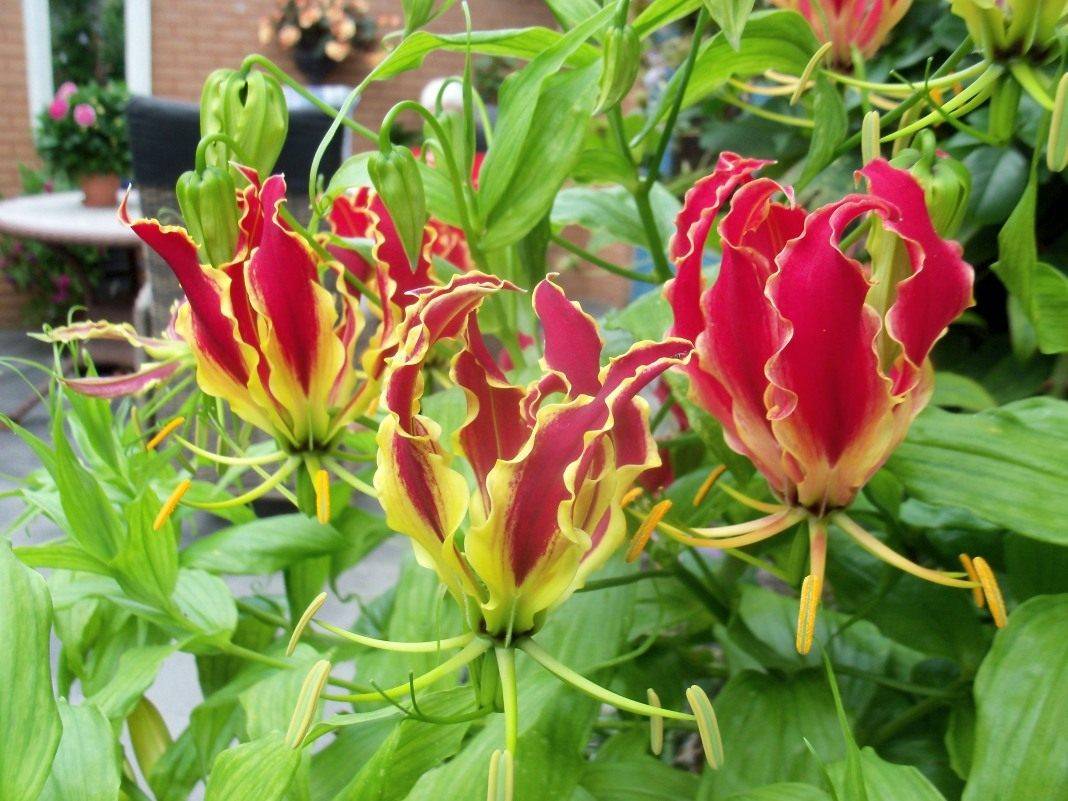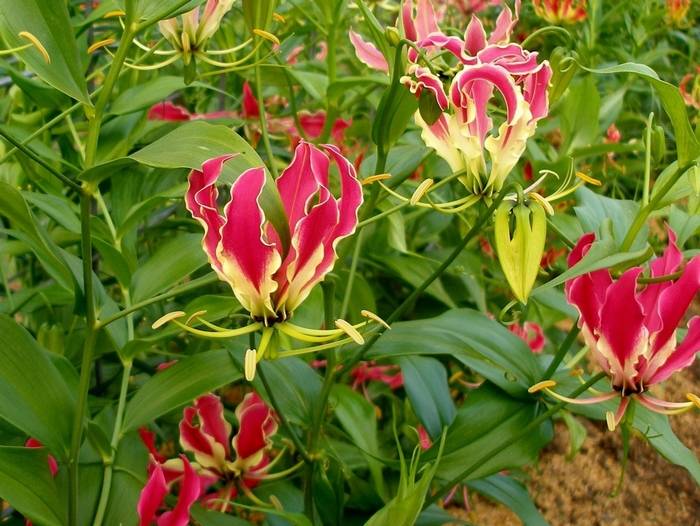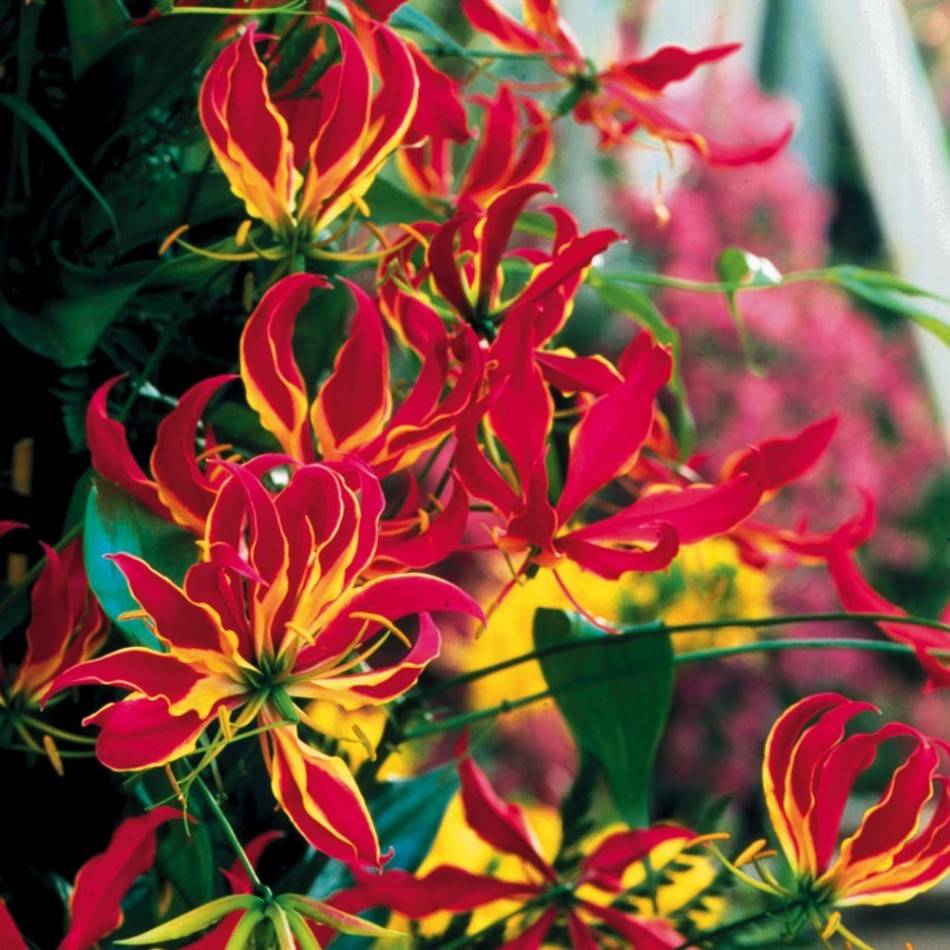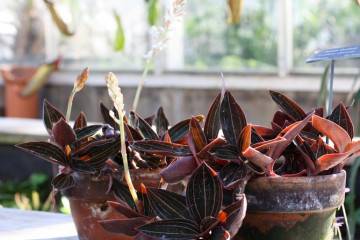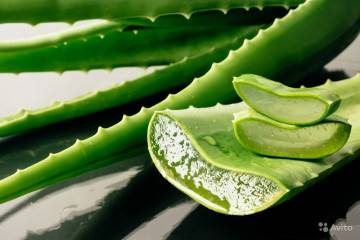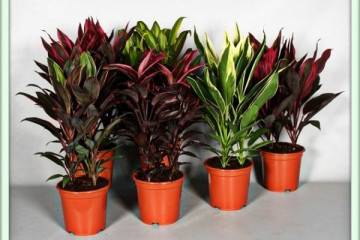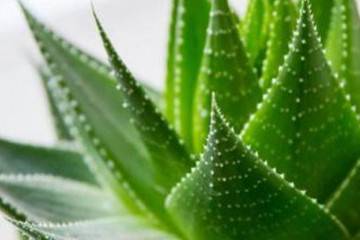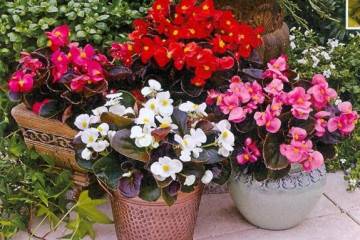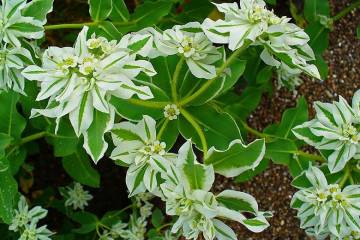Gloriosa - what kind of flower, main types
Content:
Gloriosa is a climbing houseplant that is a flowering liana. She is not considered moody. However, there are nuances that must be followed in order for gloriasis to grow and develop. The Reward for Attention is a showy plant with rich foliage and vibrant reds.
What a gloriosa flower
Gloriosa is a flower common in Africa and India. The southern representative of the flora is used to a humid climate and warmth. In the tropics, it grows rapidly and amazes with long flowering.
Brief description and history of origin
The petals of the blossoming flower resemble tongues of fire. Because of this, gloriosa is called the lily of the flame. The flowers are quite large and are found at the top of the stem. At first they have a yellowish tint, which gradually gives way to red. The border remains light for a while, and then disappears. The red color becomes more saturated.
The poisonousness of the plant
Gloriosa is poisonous. Its tubers, seeds and roots contain the alkaloid colchicine. It is a neuroparalytic poison. It is used in the treatment of gout and amyloidosis.
Colchamine, contained in the plant, is also highly toxic. When used correctly, it has healing properties and is used in medicine for the treatment of cancer.
Varieties of indoor plants
There are several types of gloriosa, each with different varieties.
Gloriosa superb
The glorious species of gloriosa is most popular with flower growers. Its stems are thin and grow up to 2 m. Gloriosa luxurious has long, thin petals. They have wavy edges and a yellowish tint. When the flower opens, they noticeably bend back.
Gloriosa simplex
The type of gloriosa is simple, more miniature:
- stems usually do not grow more than 1.5 m;
- the diameter of the flowers does not exceed 3 cm. At first they have a green tint, gradually turn yellow, and then orange;
- the edges of the petals are almost even, slightly bent back.
Gloriosa Rothschild (Gloriosa rothschildiana)
Gloriosa Rothschild is characterized by large flowers, their diameter can reach 12 cm.The petals are dark scarlet with subtle purple spots at the base. Their edges are wavy, reminiscent of corrugated paper. Planting and caring for Rothschild gloriosa does not differ from the rules for keeping other plant species.
Planting gloriosa
Usually, gloriosa is planted with tubers:
- They choose a pot and get soil. You can use a plant mix or make your own. It is necessary to mix leafy earth and humus in equal proportions, adding half the sod and a little sand.
- The tubers are planted at a slight slope. It is worth making sure that growth points are not closed. Deepen into the ground by 2-3 cm.
Description of the sequence of actions when planting seeds:
- Seeds are soaked per day in an agent that stimulates root growth.
- Prepare the soil.
- Drainage is laid at the bottom of the container, then filled with moistened soil.
- They make holes 5 mm deep and put the seeds, lightly covering them with earth.
- Create greenhouse conditions by covering the pot with plastic. It must be placed in a warm, lighted place, periodically ventilated.
Care rules
Gloriosa is an exotic flower, home to its hot tropics. Therefore, at home, you need to create similar conditions so that he feels comfortable.
The need for warmth and light
Gloriosa needs a lot of ambient light. If the plant has been in the shade for a long time, then it should be exposed to the sun gradually. The temperature regime is also important.
In winter, gloriosa is at rest. Reduce watering frequency after flowering. And after the part of the plant that is above the ground dies off, the tubers are dug out. They are stored in the dark and cool at temperatures around 10 ° C. Sprinkle them with sand on top. You can leave the tubers in the pot by transferring to a cool and dry place.
How to water gloriosa
In spring and summer, the plant should be watered abundantly, focusing on the topsoil. To avoid waterlogging, you need to make sure that it has time to dry out. Before the procedure, it is better to defend the water in advance. In the fall, watering is reduced and gradually stops. In winter, during the dormant period, it is not needed.
Gloriosa loves high humidity. It is recommended to spray it daily. In this case, it is important to use settled water and avoid getting liquid on the flowers. To create comfort, you can put the pot on a pallet with wet expanded clay and make sure that the bottom of the flowerpot does not touch the water.
Pot size
When planting tubers, it is recommended to take a pot with a diameter of 13 cm. Gloriosa is a fast-growing plant. With each subsequent transplant, you need to choose a container with a large size. The new pot should be 2 cm larger than the old one.
Pruning and replanting
Gloriosa pruning is not necessary. The procedure will not lead to the emergence of new shoots, but, on the contrary, will deprive the plant of the opportunity to bloom, because the flowers are formed at the tops of the stems.
Flowering features and problems
Gloriosa usually blooms from June to September. Each flower lasts about two weeks, and a new one comes to replace it. Therefore, the plant retains its attractive appearance for a long time.
Why gloriosa does not bloom:
- lack of sunlight;
- drafts;
- poor-quality soil, depleted in nutrients;
- improper wintering, for example, at too low temperatures;
- disease or damage to the tuber.
Activity and rest
The period of activity begins with the arrival of spring, when the tubers are planted in the soil. With proper care, the first flowers will appear at the beginning of summer. In September, they wither, gradually wither and fall off the leaves. In a young plant, the aerial part of the plant may not die off in the first year. Then you do not need to dig up the tubers, you should continue to care for the flower, reducing watering and providing heat and light.
Types and shape of flowers
Different types of gloriosa differ in appearance. The shape of the petals is preserved, but they are not similar in size, length, edges, but always thin and elongated. Their color changes from yellow to scarlet. There are petals of purple color, pale pink, orange. The buds themselves differ in size, some reach 10-15 cm in diameter, others do not exceed 3 cm.
Reproduction methods
You can propagate the plant with tubers or seeds in early March. The first method is recommended because of its simplicity.
An easy way to reproduce
When propagating by tubers, the rhizome is taken out of the ground and cut into pieces. Damaged areas must be treated with crushed activated carbon to prevent infection and spread of infection.
Seeds
The seeds can be purchased or harvested by yourself. They form at the tops of the shoots in capsules. Before that, you need to pollinate the flower by transferring the pollen from the pistil to the stamen. To do this, you can take a cotton swab. After planting the seeds, the sprouts appear in 7-8 weeks.
Growing problems, diseases, pests
Gloriosa is rarely attacked by insects. But, nevertheless, it can be harmed by aphids, scale insects and spider mites. Also, improper growing care can lead to the fact that the plant loses its attractiveness.
Ways to fight
Parasites, namely aphids and mites, do not like high humidity. Frequent spraying and insecticide treatments will help get rid of them. The shield will have to be removed manually before the procedure.
If the leaves of the gloriosa have turned pale, it does not have enough light, you need to change the position of the flower. When a white bloom has appeared on them, it is necessary to better defend the water. Yellow leaves appear with insufficient or excessive moisture, it is worth revising the conditions for keeping the plant. If the plant looks drooping, it starts to rot, this happens with over-watering.
Gloriosa is a tropical vine that can decorate any apartment. The colorful bloom will not leave anyone indifferent. To keep the bright, chic gloriosa, planting and care at home is not difficult, with the exception of one nuance. The difficulty in the need to send the plant for the winter, observing the temperature regime. But even this is easy to deal with if you re-read the article again.
